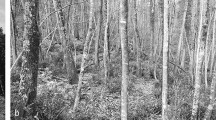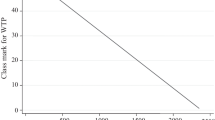Abstract
This research utilises a contingent behaviour valuation technique to value a number of improvements to recreational facilities in small-scale forests in Ireland. Willingness-to-pay estimates have previously been made for Coillte (Ireland’s state-owned forestry company) trails and forests. The total non-market value of Irish forests has also been examined. This paper adds to the literature by being the first to estimate the consumer surplus associated with recreational enhancements to Irish small-scale forest resources. The results presented indicate that community owned small-scale forestry can contribute enormously to the wellbeing of nearby urban residents, through the provision of outdoor recreational services.
Similar content being viewed by others
Notes
Usage of the small-scale forest sites by the local communities is highest during the summer months although according to the local authority in charge of the two sites, usage remains high even in winter due mainly to the close proximity of the small-scale forest sites to the urban areas.
A more thorough development of random effects models can be found in Hausman et al. (1984).
TC ij , estimated as 2 × (distance × €0.25), is the travel cost of individual i to forest site j. The distance variable is multiplied by 2 to obtain the two-way trip distance, which is then multiplied by the average petrol cost per mile (the Automobile Association of Ireland’s calculations of €0.25/mile). This is used as a proxy for the monetary travel cost. These implicit prices relate to per person trip values for visiting a forest that has specified facilities relative to not visiting the forest (i.e. staying at home). The opportunity cost of travel time is not included in the travel cost in this study. It is the authors’ judgement that trips made to the forests are made outside work hours. There is no evidence of substitution or a trade-off between going to work and partaking in recreational activities at the forest site. Indeed, Ward and Beal (2000) also considered that using a zero cost of travel time is appropriate. They considered the opportunity cost of time to be zero because individuals were assumed to travel for leisure and recreation during their holidays when there is no loss of income.
This study was unable to estimate the total annual usage of the forest sites in question, so it is not possible to calculate a total annual non-market recreational value, for comparison with that of Fitzpatrick and Associates (2005).
References
Bacon P, Associates (2004) A review and appraisal of Ireland’s forestry development strategy, Final Report. Stationery office, Dublin. http://www.agriculture.gov.ie/publicat/publications2004/forestryfinalrep.pdf (accessed 07/2006)
Clinch P (1999) The economics of Irish forestry. COFORD, Dublin
Creel MD, Loomis JB (1990) Theoretical and empirical advantages of truncated count data estimators for analysis of deer hunting in California. Am J Agri Econ 72(2):434–441
Englin J, Cameron T (1996) Enhancing travel cost models with multiple- scenario contingent behaviour data: poisson regression analysis with panel data. Environ Resour Econ 7(2):133–147
Fitzpatrick, Associates (2005) Economic value of trails and forest recreation in the Republic of Ireland. Coillte and the National Trails Strategy Working Group of the Irish Sports Council. Final Report, Dublin
Hanley N, Bell D, Alvarez-Farizo B (2002) Valuing the benefits of coastal water quality improvements using contingent and real behaviour. Environ Resour Econ 24(3):273–285
Hanley N, Ruffell R (1993) The contingent valuation of forest characteristics: two experiments. J Agri Econ 44(2):218–229
Hausman J, Hall B, Griliches Z (1984) Econometric models for count data with an application to the Patents-RandD relationship. Econometrica 52(4):909–938
Hellerstein D, Mendelsohn R (1993) A theoretical foundation for count data models. Am J Agri Econ 75(3):604–611
Hynes S, Hanley N, Christie M (2006) Measuring the benefits of improvements to forest recreational facilities. Proceedings of the small-scale forestry and rural development conference, Galway, Ireland 18–23 June
Hynes S, Hanley N (2006) Preservation versus development on Irish Rivers: whitewater kayaking and hydro power in Ireland. Land Use Policy 23(2):170–180
Mathis M, Fawcett A, Konda L (2003) Valuing nature: a survey of the non-market literature. Discussion paper VNT-03-01. Houston Advanced Research Center
Mill G, van Rensburg T, Hynes S, Dooley C (2007) The role of public preferences for enhancing biodiversity and recreation opportunities in Irish forests. Ecol Econ 60(3):642–653
Morton KM, Adamowicz WL, Boxall PC (1995) Economic effects of environmental quality change on recreational hunting in northwestern Saskatchewan: a contingent behaviour analysis. Can J Forest Res 25(6):912–920
Ni Dhubhain A, Gardiner J, Davies J, Hutchinson WG, Chilton S, Thomson K, Psaltopoulos D, Anderson C (1994) The socio-economic impacts of afforestation on rural development. Final Report to CAMAR, European Community. University College, Dublin
Scarpa R, Chilton SM, Hutchinson WG, Buongiorno J (2000) Valuing the recreational benefits from the creation of nature reserves in Irish forests. Ecol Econ 33(2):237–250
Starbuck M, Berrens R, McKee M (2006) Simulating economic impacts from hazardous fuels treatment and forest restoration management activities. Forest Policy Econ 2006(8):52–66
Ward F, Beal D (2000) Valuing nature with travel cost models: a manual. Edward Elgar, Cheltenham
Willis K, Garrod G (1992) An individual travel cost method of evaluating forest recreation. J Agri Econ 42(1):33–42
Author information
Authors and Affiliations
Corresponding author
Appendix 1 Impact of a Change in Forest Facilities
Appendix 1 Impact of a Change in Forest Facilities
Q. 8 Impact of Change in Forest Facilities.
I would now like to ask you how your use of THIS FOREST might change if new facilities were created next year. The proposed changes are described in Card 1 in your booklet.
(a) Suppose that next year, the changes described on this card were implemented in this forest, would you change the number of trips you would take to this forest over the next 12 months? When answering this question, you should consider the number of trips that you made to this forest last year (i.e. the number of trips you stated in Q. 5 above).

(b) How many more trips would you take to this forest? ___ more trips
(c) How many fewer trips would you take to this forest? ___ fewer trips
Rights and permissions
About this article
Cite this article
Hynes, S., Cahill, B. Valuing the benefits to the local community of supplying recreational facilities in community owned forests: an application of the contingent behaviour method. Small-scale Forestry 6, 219–231 (2007). https://doi.org/10.1007/s11842-007-9007-1
Received:
Revised:
Accepted:
Published:
Issue Date:
DOI: https://doi.org/10.1007/s11842-007-9007-1




